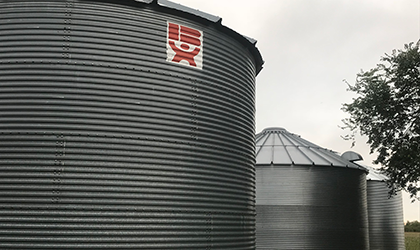September 27, 2018

Source: South Dakota State University
This article is part 1 in a 4-part series focusing on grain storage.
Written collaboratively by Sara Bauder, Jack Davis, Anthony Bly, Ruth Beck, Laura Edwards, David Karki, and Nathan Edwards.
With harvest approaching or in progress in many areas of South Dakota, grain storage is becoming a top priority for some producers. Over the past year, low commodity prices have caused some farmers to hold over more grain than in previous years. In addition, according to some experts, the current tariff situation may effect grain markets into the summer. These issues, in conjunction with high yielding areas, high humidity, the need for harvest efficiency, and commercial storage limitations/fees may cause some significant storage issues for many producers this fall. There are a few storage options available to farmers, but the main priority is a facility that is safe, keeps grain dry, and has aeration for temperature control.

Exit Strategy
This is a good time to consider exit strategy (or marketing plan) for grain, and determine if at-home storage, paid storage, or direct sale is a good option. The current projection for 2018-19 marketing year corn supply is 16.879 billion bushels, 228 million bushels smaller than last year’s supply, and the 2018-19 ending stocks-to-use ratio is the lowest it has been in recent years. Corn harvest bids are currently running at $0.55 below December futures. The soybean supply is projected at 5.113 billion bushel, 302 million bushel larger than last year’s supply, and the 2018-19 ending stocks-to-use ratio at 19.8% (Sept. 12) is the largest it has been in recent years. Soybean harvest bids are currently running $1.50 below November futures.
A producer’s storage decision is based on their storage capacity, ability to manage grain in storage, and the expected returns from storage. Current commercial storage rates vary from $0.05 to $0.07 per bushel per month, and producers should compare these rates with your on farm storage costs; include interest cost, shrink, handling cost, and drying costs. See the Cost of Storing Grain program to project grain storage costs post-harvest on your farm.
Returns to storage can be captured by selling the crop for later delivery at a price that exceeds the spot cash price plus the cost of owning and storing the crop. This can be accomplished by use of:
Forward cash contract
This type of agreement eliminates all uncertainty about the return to storage. Forward pricing eliminates downside price risk but also eliminates a return from higher price levels.
Selling deferred futures contracts. When selling a deferred futures contract to price the stored crop the basis levels will still have to be set, which can impact the actual return to storage.
Storing the crop unpriced in anticipation of higher cash prices. Storing a crop unpriced allows the producer to capture higher prices, but provides no protection from lower prices.
Alternative Storage Options
If one is determined to store more grain than you have traditional storage space for, there are a few options. Dr. Ken Hellevang of NDSU Extension is a regional grain storage expert and much of the following alternative storage information is adapted from his recommendations for the upper Midwest.
Old grain bins
Bins are an opportune storage facility due to their ability to shield grain from precipitation and allow controlled aeration for temperature and moisture control. In a pinch, some farmers may attempt using old bins that have been out of service for many years- this can be done, but safety and functionality are key. Not every bin has a perforated floor; however, they may include in-floor aeration. If no aeration exists in bins over 3,000 bushels, aeration tubes should be added for temperature control in long-term storage situations. Additionally, fan covers and proper aeration of bin roofs (i.e. roof vents) are often overlooked but considered highly useful tools in keeping grain cool for long periods of time as well. Be sure old bins are assessed for structural integrity, tight seals (especially between the floor and base of the walls), and are sanitized to the specifications referenced near the end of this article.
Grain Piles
Commonly seen at grain elevators and coops, piles can be a short-term solution to a grain storage issue. However, open piles are completely vulnerable to moisture damage. Although many believe that wind blowing on an open pile can aerate it, this is simply not the case. A 1-inch rain can increase a 1-foot layer of corn by 9% moisture (Hellavang, 2018). Covers are available for grain piles that can help shield grain from the elements and direct drainage away from the pile. In addition, aeration systems can be added to piles. Sometimes producers have to weigh the cost of spoiled grain against to the cost of a cover and aeration system based upon intended length of storage. Be sure to prepare the ground surface with a substance that has low permeability (lime, asphalt, cement, etc.) and add a crown for proper water drainage. Consider locating piles away from possible flood areas and near electricity if aeration will be used. Grain placed in piles should be dry to control temperature; ideally corn should be at 13-14%, and soybeans at 11-12% moisture.
Bag storage
Poly bag storage is often considered a wet grain storage option, but in reality can be used for dry grains as well. Grain should be put in bags dry (soybean 11-12%, corn 13-14%), considering potential storage period. Poly bags do not stop insect infestations, mold growth, or heating, making it imperative that grain is properly dried before using bags. If heating within the bag occurs, one detriment to this type of storage is that controlled aeration is not a viable option. Running bags north to south can help reduce moisture issues and keep heat more even throughout the day.
Other structural facilities on your farm. Some farms may have older granary spaces or buildings that could be repurposed or put back into service. Remember that grain can push against walls, and buildings may need extra reinforcement. Look for bowed walls or other structural issues before attempting to fill such structures. Consider the load the building was designed to withstand before moving any grain. If using a facility not originally intended for grain storage, it’s best to hire an engineer to complete a structural analysis or (at a minimum) limit grain coverage to the floor only, avoiding adding a load to the exterior walls.
Sanitizing Facilities
Preparing to store grain in any of the above facilities should include thorough cleaning and preparation. Remember that new grain should never be stored on top of old grain. View How to Prevent Stored Grain Pests for a specific list of sanitation procedures that should be performed every year, before any grain is stored.
For specific information regarding different grain storage facilities see NDSU’s Grain Drying and Storage page.
Originally posted by South Dakota State University.
You May Also Like




